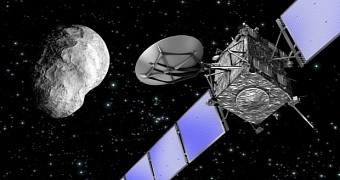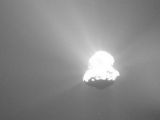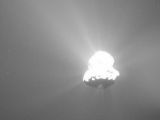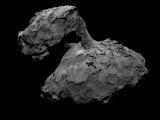A few weeks ago, in mid-March, the European Space Agency's Rosetta spacecraft chanced to witness a dust jet coming to life on the surface of Comet 67P/Churyumov-Gerasimenko.
The event was documented by the spacecraft's OSIRIS scientific imaging system and the resulting images were released to the public this past Monday, April 20. You can find them in the gallery below.
This dust jet was the first ever observed by Rosetta
As detailed by mission scientists with the European Space Agency, the dust jet observed by Rosetta on Comet 67P/Churyumov-Gerasimenko burst into being on March 12.
The first of the two images produced by the OSIRIS scientific imaging system was taken at 07:13 CET (Central European Times). In this picture, the comet's dark underside looks calm and peaceful.
The second image, which was taken just a couple of minutes later, shows the jet coming alive and hurling dust from the surface of Comet 67P/Churyumov-Gerasimenko into space.
To show exactly how the jet animated things on the Rosetta spacecraft's target comet, astronomers used the two images to put together a short animation, also included in the gallery below.
It is understood that, at the time when the dust jet came to life, the European Space Agency's probe was positioned at a distance of merely 75 kilometers (about 46 miles) from the celestial body.
This explains why the pictures delivered by the spacecraft's OSIRIS scientific imaging system are so clear and why the dust jet is clearly visible leaving the comet's surface.
Although the Rosetta spacecraft has been orbiting Comet 67P/Churyumov-Gerasimenko since August 2014, the March 12 event was the first dust jet ever observed by the probe on its target.
“This was a chance discovery. No one has ever witnessed the wake-up of a dust jet before,” said researcher Holger Sierks with the Max Planck Institute for Solar System Research in Germany.
How the March 12 dust jet on 67P/C-G came to happen
Comet 67P/Churyumov-Gerasimenko is now traveling towards the Sun and is set to make its closest approach to our parent star in about four months, astronomers explain.
The closer to the Sun it gets, the warmer its nucleus becomes. As a result, frozen gases on its surface instantly turn into vapors and shoot into space, carrying dust with them.
Mission scientists expect that, as its orbit takes it closer and closer to the Sun, Comet 67P/Churyumov-Gerasimenko will witness an ever increasing number of dust jets forming on its surface.
“As the comet moves closer to the Sun along its orbit, its nucleus gets warmer and warmer,” European Space Agency researchers explained such events in a statement.
“Frozen gases sublimate from its surface, carrying dust particles with it and enshrouding the nucleus in a dense coma,” the astronomers went on to detail the birth of such dust jets.

 14 DAY TRIAL //
14 DAY TRIAL // 



